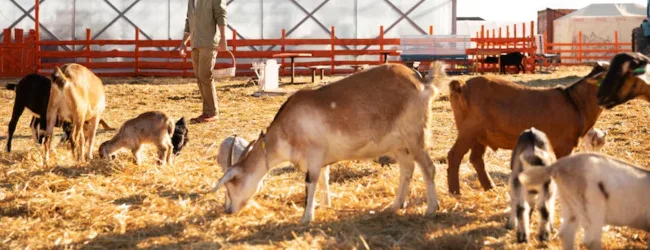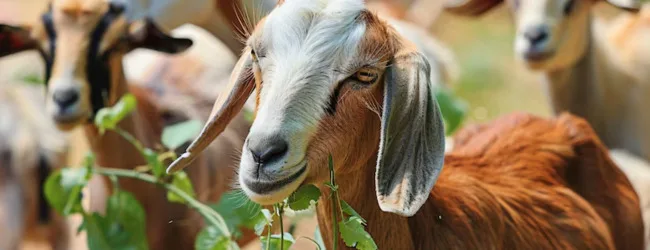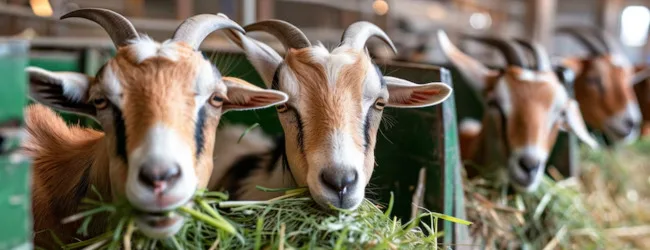Table of contents
- Why Consider Goat Farming in India?
- Step-by-Step Guide to Starting Your Goat Farming Business
- Step 1: Research and Create Your Goat Farming Business Plan
- Step 2: Select the Right Goat Breed
- Step 3: Choose a Location and Build Housing
- Step 4: Procure Healthy Goats
- Step 5: Ensure Proper Feeding and Nutrition
- Step 6: Implement Healthcare and Disease Management
- Step 7: Manage Breeding Effectively
- Step 8: Marketing and Selling Your Produce
- Step 9: Maintain Records and Manage Finances
- Common Challenges in Goat Farming
- Government Schemes and Support in India
- Conclusion
- Frequently Asked Questions (FAQs)
Goat farming, or capriculture, is a promising livestock enterprise gaining significant traction across India. With relatively low initial investment compared to other livestock farming and high demand for goat meat (chevon) and milk, it presents a lucrative opportunity for farmers and entrepreneurs. But, like any venture, success hinges on proper planning and execution. This guide provides a step-by-step approach to starting your goat farming business in India, with a special focus on creating a solid goat farming business plan.
India has a massive goat population (over 150 million, contributing significantly to global numbers), reflecting the animal’s adaptability and economic importance. Let’s dive into how you can tap into this potential.
Why Consider Goat Farming in India?
Before drafting your goat farming business plan, understand the advantages:
- High Demand: There’s a consistent and growing demand for goat meat (chevon) and milk in India. Goat meat is preferred by many communities, and goat milk is valued for its nutritional benefits (easier to digest than cow’s milk).
- Low Initial Investment: Compared to dairy or poultry farming, setting up a small-to-medium scale goat farm requires less capital. Goats don’t need elaborate housing.
- Adaptability: Goats are hardy animals that can adapt to various agro-climatic conditions across India, from arid Rajasthan to humid Kerala. They can thrive on diverse vegetation.
- High Reproduction Rate: Goats generally have a short gestation period (around 150 days) and often give birth to twins or triplets, leading to faster herd growth.
- Multiple Income Streams: Revenue can come from selling live animals, meat, milk, manure (excellent organic fertilizer), and sometimes fiber (like Pashmina from specific breeds).
- Government Support: Various central and state government schemes, including subsidies and loans through institutions like NABARD (National Bank for Agriculture and Rural Development), support goat farming.
Step-by-Step Guide to Starting Your Goat Farming Business
A successful venture requires meticulous planning. Here’s how to proceed:

Step 1: Research and Create Your Goat Farming Business Plan
This is the cornerstone of your venture. Your goat farming business plan should be a detailed document outlining every aspect of your proposed farm. It’s essential not just for clarity but also for securing loans or subsidies.
Key Components of Your Goat Farming Business Plan:
- Executive Summary: A brief overview of your entire plan.
- Business Objectives:
- What is your primary goal? (Meat production, milk production, breeding, or integrated farming).
- What scale do you intend to operate at (small, medium, large)?
- What are your growth projections for the next 3-5 years?
- Market Analysis:
- Assess local demand for goat meat, milk, or live animals.
- Identify your target customers (local butchers, markets, restaurants, dairy cooperatives, individual consumers).
- Analyze competitors in your area.
- Determine pricing strategies.
- Operational Plan:
- Breed Selection: Which breeds are suitable for your goals and local climate? (More on this in Step 2).
- Location & Housing: Details about land, shed construction, fencing, and infrastructure (water, electricity).
- Feeding Strategy: Plan for fodder cultivation or procurement, feed composition, and costs.
- Healthcare Plan: Vaccination schedule, deworming plan, emergency protocols, veterinary contacts.
- Breeding Plan: Strategy for managing bucks and does, kidding management.
- Labour: Requirement for skilled/unskilled labour.
- Financial Projections:
- Initial Investment: Cost of land (if purchasing/leasing), shed construction, purchasing initial stock, equipment, registration fees.
- Working Capital: Ongoing costs like feed, veterinary care, labour wages, utilities, transportation.
- Revenue Projections: Estimated income from selling animals, milk, manure, etc.
- Profitability Analysis: Break-even point, projected profit margins.
- Funding Request: If seeking loans, specify the amount required and its utilization. (Highlight: A detailed financial plan is crucial for loan applications via schemes like NABARD).
- Marketing and Sales Strategy: How will you reach your target market and sell your products?
- Risk Assessment: Identify potential risks (disease outbreaks, market fluctuations, climate issues, theft) and outline mitigation strategies.
- Legal & Regulatory Compliance: Licenses needed (local panchayat/municipality NOC), registration, animal welfare regulations.
Highlight: Treat your goat farming business plan as a living document; review and update it regularly.
Step 2: Select the Right Goat Breed
Choosing the right breed is critical and depends on your primary objective (meat, milk, dual-purpose) and local conditions. Some popular Indian breeds include:
- Black Bengal: Found primarily in Eastern India (West Bengal, Odisha, Bihar). Known for high fertility, excellent meat quality, and good skin. Small size.
- Barbari: Found in Uttar Pradesh and Haryana. Small-sized, good milk producer, known for kidding twice a year, suitable for stall-fed systems.
- Jamunapari: Native to Uttar Pradesh. Large size, good milk yield, but lower reproduction rate. Suitable for meat and milk.
- Sirohi: From Rajasthan. Medium to large size, primarily reared for meat. Tolerant to heat and adaptable.
- Beetal: Found in Punjab and Haryana. Large size, good milk producer, similar to Jamunapari but with higher prolificacy. Good for meat too.
- Osmanabadi: From Maharashtra. Primarily for meat, also gives decent milk. High disease resistance.
- Tellicherry (Malabari): From Kerala. Good for meat and milk, known for multiple births.
Highlight: Consult local agriculture universities or Krishi Vigyan Kendras (KVKs) for advice on breeds best suited for your region.
Step 3: Choose a Location and Build Housing

- Location: Select a site preferably away from urban areas, with good access to roads, clean water, and electricity. Ensure land availability for fodder cultivation if possible, as this significantly reduces feed costs.
- Housing (Shed):
- Goats need protection from extreme weather (heavy rain, intense sun, cold winds) and predators.
- The shed should be well-ventilated, dry, and clean.
- Space: Provide adequate space per goat (approx. 10-12 sq. ft. per adult goat, more for bucks and pregnant does).
- Flooring: Raised platform (slatted floor) housing is recommended, especially in high rainfall areas, to keep goats dry and manage manure easily. Otherwise, a clean, dry earthen or concrete floor with bedding (like paddy straw) works.
- Fencing: Strong fencing is essential to prevent goats from wandering off and protect them from predators.
Do you want to learn the Goat Farming Business from experts?
Master profitable goat and sheep farming business with our expert-led course — https://bw1.in/1964
Learn how to start a Beetal goat farming business and boost your income — https://bw1.in/1961
Step 4: Procure Healthy Goats
- Start with a small herd (e.g., 10-20 does and 1 buck) to gain experience.
- Purchase goats from reputable breeders or certified government farms. Avoid buying from local markets where disease history might be unknown.
- What to look for: Active and alert animals, shiny coat, proper body condition (not too thin), no signs of disease (like coughing, nasal discharge, diarrhoea, limping). Check age (usually by teeth). It’s often best to buy young, recently weaned kids or doelings.
Step 5: Ensure Proper Feeding and Nutrition
- Feeding constitutes a major portion (around 60-70%) of the operational cost. Efficient feed management is key to profitability.
- Feed Components:
- Green Fodder: Natural grasses, cultivated fodder crops (like maize, sorghum, Napier grass, legumes like Berseem, Lucerne), tree leaves (Subabul, Neem, Babul). Aim to provide as much green fodder as possible.
- Dry Fodder: Straw (paddy, wheat), dried grasses, legume hay. Essential for roughage.
- Concentrates: Grains (maize, barley, oats), oil cakes (groundnut cake, soybean meal), bran (rice, wheat), mineral mixture. Provide supplementary energy and protein, especially for growing kids, pregnant/lactating does, and breeding bucks.
- Water: Clean, fresh drinking water must be available at all times.
- Highlight: Growing your own fodder significantly reduces costs. Plan for year-round fodder availability.
Step 6: Implement Healthcare and Disease Management
- Prevention is better than cure. A strict health calendar is vital.
- Vaccination: Vaccinate goats against common diseases like PPR (Peste des Petits Ruminants), ET (Enterotoxemia), FMD (Foot and Mouth Disease), and Goat Pox as per veterinary advice and local disease prevalence.
- Deworming: Regularly deworm goats (internal and external parasites) as parasites severely affect health and productivity. Consult a vet for the appropriate schedule and dewormer.
- Hygiene: Maintain clean sheds, feeders, and waterers. Isolate sick animals immediately. Practice proper disposal of manure and waste.
- Veterinary Care: Have a good relationship with a local veterinarian for regular check-ups and emergencies.
Step 7: Manage Breeding Effectively

- Select healthy, genetically superior bucks and does for breeding. Avoid inbreeding.
- Maintain a proper buck-to-doe ratio (e.g., 1 buck for 25-30 does).
- Provide extra nutrition to pregnant and lactating does and breeding bucks.
- Manage kidding carefully: ensure a clean, dry space for kidding and provide necessary care to newborns (colostrum feeding, navel cord disinfection).
Step 8: Marketing and Selling Your Produce
- Explore different marketing channels detailed in your goat farming business plan:
- Local Markets (Mandis/Haats): Selling live animals.
- Butcher Shops: Direct supply of goats for meat.
- Restaurants/Hotels: Supplying chevon.
- Direct Consumers: Selling meat or milk directly (requires processing/hygiene standards).
- Dairy Cooperatives/Processors: Selling goat milk (if scale permits and demand exists).
- Festivals: Demand for goats often surges during festivals like Eid al-Adha (Bakrid). Plan accordingly.
- Build relationships with potential buyers early on. Ensure fair pricing based on weight, age, and breed quality.
Step 9: Maintain Records and Manage Finances
- Record Keeping: Maintain detailed records of everything: animal identification, breeding dates, kidding details, vaccinations, deworming, illnesses, feed consumption, purchases, sales, expenses, income. This helps in analysis and decision-making.
- Financial Management: Regularly track income and expenses against the projections in your goat farming business plan. Monitor cash flow closely.
Common Challenges in Goat Farming

Be prepared for potential hurdles:
- Disease Outbreaks: Can cause significant losses if not managed proactively.
- Feed Availability and Cost: Fluctuation in fodder availability and concentrate prices impacts profitability.
- Market Price Volatility: Prices for live goats or meat can fluctuate based on season and demand.
- Predators: Protecting goats from dogs, wild animals.
- Lack of Skilled Labour: Finding trained personnel for farm management can be difficult.
- Climate Risks: Droughts or floods can affect fodder availability and animal health.
Government Schemes and Support in India
The Indian government, through NABARD and the National Livestock Mission (NLM), offers various schemes, including subsidies and loans for goat farming. State governments also have specific programs.
- NABARD: Provides refinance assistance to banks for extending loans for various agricultural activities, including goat farming. They have model project reports available.
- National Livestock Mission (NLM): Often includes components supporting small ruminant (sheep and goat) development, focusing on breed improvement, entrepreneurship development, and risk management.
Highlight: Visit the official websites of NABARD, the Department of Animal Husbandry & Dairying (DAHD), and your state’s animal husbandry department for the latest schemes and application procedures.
Need Expert Guidance?
Starting a business can be challenging, but you don’t have to do it alone! At Boss Wallah, our 2,000+ business experts are ready to provide valuable insights and guidance. Whether you need help with marketing, finance, sourcing, or any other area of any business, our business experts are here to help you succeed- https://bw1.in/1116
Confused about Which Business to Start?
Want to start your own business but unsure which one to choose? Explore Boss Wallah, where you’ll find 500+ courses by successful business owners, featuring practical, step-by-step guides on starting and growing various businesses.
Find your perfect business idea today – https://bw1.in/1111
Conclusion
Goat farming in India offers substantial economic potential, especially with the rising demand for goat products. However, success isn’t guaranteed. It requires dedication, hard work, and most importantly, meticulous planning. A comprehensive goat farming business plan acts as your roadmap, guiding you through breed selection, housing, feeding, healthcare, marketing, and financial management. By combining traditional knowledge with modern practices and leveraging available government support, you can build a profitable and sustainable goat farming enterprise in India.
Frequently Asked Questions (FAQs)
1. How much investment is needed to start goat farming in India?
The initial investment varies greatly depending on the scale, location (land cost), breed, and whether you build new infrastructure or use existing facilities. A small unit (20 does + 1 buck) might require anywhere from ₹1.5 Lakhs to ₹5 Lakhs or more, excluding land cost. A detailed goat farming business plan will give you a specific estimate.
2. Is goat farming profitable in India?
Yes, goat farming can be very profitable if managed efficiently. Profitability depends on factors like breed selection, low mortality rates, good feeding management (especially low feed cost), and effective marketing. Returns typically start coming in within 18-24 months.
3. Which goat breed is best for farming in India?
There’s no single “best” breed. It depends on your goal (meat/milk/dual) and local climate. Black Bengal is great for meat in the East, Barbari for stall-feeding & milk, Jamunapari/Beetal for milk & meat in the North, and Sirohi/Osmanabadi for meat in arid/semi-arid regions. Research local adaptable breeds.
4. How much land is required for goat farming?
For housing alone, around 10-12 sq. ft. per adult goat inside the shed plus some open paddock space is needed. If you plan to cultivate fodder, you’ll need significantly more land (e.g., 0.5 to 1 acre per 20-30 goats, depending on fodder type and yield). Stall-fed systems require less land than free-range systems.
5. Can I get a loan for goat farming in India?
Yes, several banks offer loans for goat farming, often refinanced by NABARD under various agricultural loan schemes. A solid goat farming business plan is crucial for securing a loan. Government subsidies may also be available under schemes like NLM.
6. What are the major risks in goat farming?
The main risks include high mortality due to diseases (like PPR, ET), parasite infestations, fluctuating market prices, feed shortages or high costs, theft, and predator attacks. Proper management, vaccination, and biosecurity can mitigate many risks.
7. Do I need training for goat farming?
While not mandatory, undergoing training is highly recommended. Many Agricultural Universities, KVKs (Krishi Vigyan Kendras), and State Animal Husbandry Departments offer short training programs on scientific goat management, which covers breeding, feeding, healthcare, and marketing.
8. How quickly do goats reproduce?
Goats typically reach maturity between 6 and 12 months (breed dependent). The gestation period is about 5 months (150 days). Many Indian breeds can kid once a year, and some (like Barbari, Black Bengal) can kid twice in 14-18 months, often producing twins or triplets, leading to rapid herd growth.


